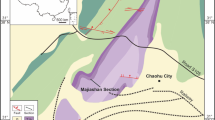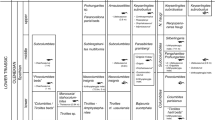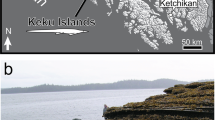Abstract
The fossil record of the earliest tetrapods (vertebrates with limbs rather than paired fins) consists of body fossils and trackways. The earliest body fossils of tetrapods date to the Late Devonian period (late Frasnian stage) and are preceded by transitional elpistostegids such as Panderichthys and Tiktaalik that still have paired fins. Claims of tetrapod trackways predating these body fossils have remained controversial with regard to both age and the identity of the track makers. Here we present well-preserved and securely dated tetrapod tracks from Polish marine tidal flat sediments of early Middle Devonian (Eifelian stage) age that are approximately 18 million years older than the earliest tetrapod body fossils and 10 million years earlier than the oldest elpistostegids. They force a radical reassessment of the timing, ecology and environmental setting of the fish–tetrapod transition, as well as the completeness of the body fossil record.
This is a preview of subscription content, access via your institution
Access options
Subscribe to this journal
Receive 51 print issues and online access
$199.00 per year
only $3.90 per issue
Buy this article
- Purchase on Springer Link
- Instant access to full article PDF
Prices may be subject to local taxes which are calculated during checkout





Similar content being viewed by others
References
Lebedev, O. A. The first find of a Devonian tetrapod in USSR. Dokl. Akad. Nauk SSSR [in Russian] 278, 1407–1413 (1984)
Coates, M. I. & Clack, J. A. Polydactyly in the earliest known tetrapod limbs. Nature 347, 66–67 (1990)
Ahlberg, P. E. Tetrapod or near-tetrapod fossils from the Upper Devonian of Scotland. Nature 354, 298–301 (1991)
Ahlberg, P. E., Luksevics, E. & Lebedev, O. The first tetrapod finds from the Devonian (Upper Famennian) of Latvia. Phil. Trans. R. Soc. B 343, 303–328 (1994)
Daeschler, E. B., Shubin, N. H., Thomson, K. S. & Amaral, W. W. A Devonian tetrapod from North America. Science 265, 639–642 (1994)
Ahlberg, P. E. Elginerpeton pancheni and the earliest tetrapod clade. Nature 373, 420–425 (1995)
Lebedev, O. A. & Coates, M. I. The postcranial skeleton of the Devonian tetrapod Tulerpeton curtum . Zool. J. Linn. Soc. 113, 307–348 (1995)
Coates, M. I. The Devonian tetrapod Acanthostega gunnari Jarvik: postcranial anatomy, basal tetrapod interrelationships and patterns of skeletal evolution. Trans. R. Soc. Edinb. Earth Sci. 87, 363–421 (1996)
Ahlberg, P. E. Postcranial stem tetrapod remains from the Devonian of Scat Craig, Morayshire, Scotland. Zool. J. Linn. Soc. 122, 99–141 (1998)
Ahlberg, P. E. & Clack, J. A. Lower jaws, lower tetrapods—a review based on the Devonian genus Acanthostega . Trans. R. Soc. Edinb. Earth Sci. 89, 11–46 (1998)
Daeschler, E. B. Early tetrapod jaws from the Late Devonian of Pennsylvania, USA. J. Paleontol. 74, 301–308 (2000)
Ahlberg, P. E., Luksevics, E. & Mark-Kurik, E. A near-tetrapod from the Baltic Middle Devonian. Palaeontology 43, 533–548 (2000)
Zhu, M., Ahlberg, P. E., Zhao, W. & Jia, L. First Devonian tetrapod from Asia. Nature 420, 760–761 (2002)
Clack, J. A. et al. A uniquely specialized ear in a very early tetrapod. Nature 425, 66–69 (2003)
Clement, G. et al. Devonian tetrapod from Western Europe. Nature 427, 412–413 (2004)
Lebedev, O. A. A new tetrapod Jakubsonia livnensis from the Early Famennian (Devonian) of Russia and palaeoecological remarks on the Late Devonian tetrapod habitats. Acta Univ. Latviensis 679, 79–98 (2004)
Shubin, N. H., Daeschler, E. B. & Coates, M. I. The early evolution of the tetrapod humerus. Science 304, 90–93 (2004)
Ahlberg, P. E., Clack, J. A. & Blom, H. The axial skeleton of the Devonian tetrapod Ichthyostega . Nature 437, 137–140 (2005)
Ahlberg, P. E., Clack, J. A., Luksevics, E., Blom, H. & Zupins, I. Ventastega curonica and the origin of tetrapod morphology. Nature 453, 1199–1204 (2008)
Callier, V., Clack, J. A. & Ahlberg, P. E. Contrasting developmental trajectories in the earliest known tetrapod forelimbs. Science 324, 364–367 (2009)
Clack, J. A. Gaining Ground: The Origin and Early Evolution of Tetrapods (Indiana Univ. Press, 2002)
Schultze, H. P. & Arsenault, M. The panderichthyid fish Elpistostege: a close relative of tetrapods? Palaeontology 28, 293–309 (1985)
Vorobyeva, E. I. & Schultze, H. P. in Origins of the Higher Groups of Tetrapods (eds Schultze, H. P. & Trueb, L.) 68–109 (Cornell, 1991)
Vorobyeva, E. & Kuznetsov, A. in Fossil Fishes as Living Animals (ed. Mark-Kurik, E.) 131–140 (Academy of Sciences of Estonia, 1992)
Vorobyeva, E. I. The shoulder girdle of Panderichthys rhombolepis (Gross) (Crossopterygii), Upper Devonian, Latvia. Geobios 19, 285–288 (1995)
Boisvert, C. A. The pelvic fin and girdle of Panderichthys and the origin of tetrapod locomotion. Nature 438, 1145–1147 (2005)
Brazeau, M. D. & Ahlberg, P. E. Tetrapod-like middle ear architecture in a Devonian fish. Nature 439, 318–321 (2006)
Boisvert, C. A., Mark-Kurik, E. & Ahlberg, P. E. The pectoral fin of Panderichthys and the origin of digits. Nature 456, 636–638 (2008)
Daeschler, E. B., Shubin, N. H. & Jenkins, F. A. A Devonian tetrapod-like fish and the evolution of the tetrapod body plan. Nature 440, 757–763 (2006)
Shubin, N. H., Daeschler, E. B. & Jenkins, F. A. The pectoral fin of Tiktaalik rosae and the origin of the tetrapod limb. Nature 440, 764–771 (2006)
Downs, J. P., Daeschler, E. B., Jenkins, F. A. & Shubin, N. H. The cranial endoskeleton of Tiktaalik roseae . Nature 455, 925–929 (2008)
Ahlberg, P. E. & Johanson, Z. Osteolepiforms and the ancestry of tetrapods. Nature 395, 792–794 (1998)
Gradstein, F., Ogg, J. & Smith, A. A Geologic Time Scale 2004. (Cambridge Univ. Press, 2004)
Warren, J. W. & Wakefield, N. A. Trackways of tetrapod vertebrates from the Upper Devonian of Victoria, Australia. Nature 238, 469–470 (1972)
Warren, A. A., Jupp, R. & Bolton, B. Earliest tetrapod trackway. Alcheringa 10, 183–186 (1986)
Stössel, I. The discovery of a new Devonian tetrapod trackway in SW Ireland. J. Geol. Soc. 152, 407–413 (1995)
Clack, J. A. Devonian tetrapod trackways and trackmakers; a review of the fossils and footprints. Palaeogeogr. Palaeoclimatol. Palaeoecol. 130, 227–250 (1997)
Gourmanis, C., Webb, J. A. & Warren, A. A. Fluviodeltaic sedimentology and ichnology of part of the Silurian Grampians Group, western Victoria. Aust. J. Earth Sci. 50, 811–825 (2003)
Williams, E. A., Sergeev, S. A., Stössel, I. & Ford, M. An Eifelian U-Pb zircon date for the Enagh Tuff Bed from the Old Red Sandstone of the Munster Basin in NW Iveragh, SW Ireland. J. Geol. Soc. 154, 189–193 (1997)
Turnau, E. & Racki, G. Givetian palynostratigraphy and palynofacies: new data from the Bodzentyn Syncline (Holy Cross Mountains, central Poland). Rev. Palaeobot. Palynol. 106, 237–271 (1999)
Szulczewski, M. Depositional evolution of the Holy Cross Mts. (Poland) in the Devonian and Carboniferous—a review. Geol. Q. 39, 471–488 (1995)
Narkiewicz, K. & Narkiewicz, M. Mid Devonian carbonate platform development in the Holy Cross Mts. area (central Poland): new constraints from the conodont Bipennatus fauna. N. J. Geol. Paläontol. (in the press)
Pajchlowa, M. The Devonian in the Grzegorzowice-Skały Profile. Biuletyn Instytutu Geologicznego [in Polish]. 122, 145–254 (1957)
Adamczak, F. Middle Devonian Podocopida (Ostracoda) from Poland; their morphology, systematics and occurrence. Senckenbergiana lethaea 57, 265–467 (1976)
Malec, J. & Turnau, E. Middle Devonian conodont, ostracod and miospore stratigraphy of the Grzegorzowice–Skały section, Holy Cross Mountains, Poland. Bull. Pol. Acad. Sci. Earth Sci. 45, 67–86 (1997)
Zhu, M. et al. The oldest articulated osteichthyan reveals mosaic gnathostome characters. Nature 458, 469–474 (2009)
Markey, M. J. & Marshall, C. R. Terrestrial-style feeding in a very early aquatic tetrapod is supported by evidence from experimental analysis of suture morphology. Proc. Natl Acad. Sci. USA 104, 7134–7138 (2007)
Kurss, V. in Fossil Fishes as Living Animals (ed. Mark-Kurik, E.) 251–260 (Academy of Sciences of Estonia, 1992)
Trewin, N. H. Palaeoecology and sedimentology of the Achanarras fish bed of the Middle Old Red Sandstone, Scotland. Trans. R. Soc. Edinb. Earth Sci. 77, 21–46 (1986)
Scotese, C. R. PALEOMAP 〈http://www.scotese.com〉 (2002)
Acknowledgements
We thank G. Pieńkowski, Z. Złonkiewicz, S. Salwa (Polish Geological Institute, Warsaw and Kielce) and J. Dzik (Polish Academy of Sciences and Warsaw University) for their help in fieldwork. This research was supported, in part, by funding from the Faculty of Biology, Warsaw University and Polish Geological Institute. We thank J. O. Ebbestad (Museum of Evolution, Uppsala University) for help with preparing plaster casts of the trackways and P. Ślipiński (Museum and Institute of Zoology, PAN) for help with scanning. I. Jackson (Uppsala University) corrected the English of the Supplementary Information text. P.E.A. acknowledges the support of the Swedish Research Council.
Author Contributions G.N., P.S., K.N. and M.N. discovered and collected the Zachełmie footprints, wrote the Supplementary Information text, and provided all photographs and all geological information about the locality. G.N. invited P.E.A. to participate in the study. P.E.A. identified the footprints as tetrapod and wrote the main text in consultation with G.N.
Author information
Authors and Affiliations
Corresponding author
Supplementary information
Supplementary Information
This file contains Supplementary Notes, Supplementary References, List of Supplementary Track Specimens and Supplementary Figures 1-25 with Legends. (PDF 17634 kb)
Supplementary Movie 1
This movie was generated from a surface scan of Muz. PGI 1728.II.1, the best-preserved single footprint and shows the entire print. (MPG 1829 kb)
Supplementary Movie 2
This movie was generated from a surface scan of Muz. PGI 1728.II.1, the best-preserved single footprint and shows the foot and digits in close-up. (MPG 1822 kb)
Rights and permissions
About this article
Cite this article
Niedźwiedzki, G., Szrek, P., Narkiewicz, K. et al. Tetrapod trackways from the early Middle Devonian period of Poland. Nature 463, 43–48 (2010). https://doi.org/10.1038/nature08623
Received:
Accepted:
Issue Date:
DOI: https://doi.org/10.1038/nature08623
This article is cited by
-
Paleoenvironments of Late Devonian tetrapods in China
Scientific Reports (2023)
-
Morphology of Palaeospondylus shows affinity to tetrapod ancestors
Nature (2022)
-
Clues to the identity of the fossil fish Palaeospondylus
Nature (2022)
-
Skepticism, the critical standpoint, and the origin of birds: a partial critique of Havstad and Smith (2019)
Biology & Philosophy (2022)
-
Sustained high rates of morphological evolution during the rise of tetrapods
Nature Ecology & Evolution (2021)
Comments
By submitting a comment you agree to abide by our Terms and Community Guidelines. If you find something abusive or that does not comply with our terms or guidelines please flag it as inappropriate.



